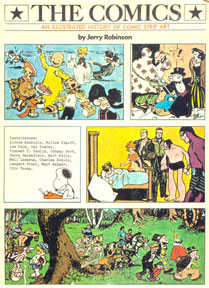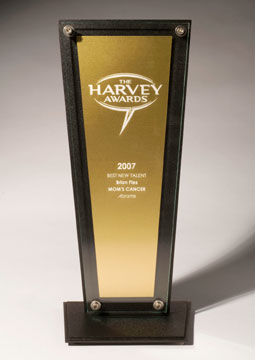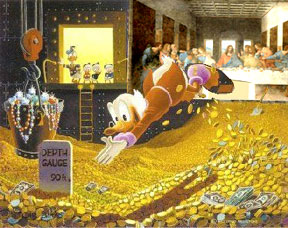
Wednesday, October 31, 2007
Ridiculous, Meet Sublime

Tuesday, October 30, 2007
Three Shades
.
(That last is a joke, but in fact I think few people making a living cartooning today--some very celebrated and successful--could have gotten a job in the 1950s. There are some legitimate reasons for that: styles and tastes change, and modern readers value a quirky authorial voice. That's great. Still, I can't think of more than a dozen contemporary cartoonists who would've been fit to clean brushes for Walt Kelly, Milt Caniff, Will Eisner or Stan Drake. Including me. Those artists knew so much we don't even know we don't know.)
.
However, I drew some stuff in the past few days that I thought turned out all right and might make a nice "How To" post. I noticed I'd used three different techniques to show the boundary between light and dark on a shaded object, and thought I could write about the techniques and the thinking behind them.

This is pretty simple but also exacting and a bit tedious. I'd use it to shade a smooth but not necessarily shiny object in bright light; it also makes a fine "Ka-Pow!" effect. Using a crow-quill nib, I start each line at the narrow pointy end nearest the light source and pull the pen toward me, pressing down gradually to make the line thicker as it goes.
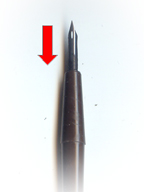
You can do this very precisely using a straight edge to make sure the lines are straight and all converge to a single point. In this case I wanted to suggest a less even surface so I did it freehand. I wanted them wiggly and uneven.
The next surface is illuminated by a single bright light source that casts deep shadows. In this case, it's a cavern wall.
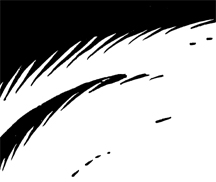
I do about 80% of my cartooning with a brush, this included. The technique is almost the same as above: starting at the pointy end of each shadowy spike, I pull the brush toward me (toward the top in this picture) and apply more pressure to widen it as I go.
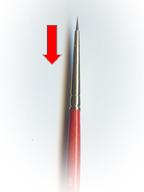
You can pull the brush at the same angle for every point or, as I did here, change the angles to suggest and enhance the curve of the surface. Each gives you a different look.
The surface below is a hard, dark, and metallic. The points showing the transition from light to shadow are short because the edge is sharp.
.

I could very well have just drawn a straight line instead, but wanted to suggest a rough texture, like iron. I used the same brush here, and again started with the tip at the pointy end of each spike. But instead of pulling the brush backward, I swept it sideways to make a thicker sawtooth line.

I only notice now that I haven't done any cross-hatching lately. I can cross hatch; I guess I'm just going for a cleaner, slicker look than that. In general, when I find myself wondering if I should cross hatch an area, I decide I'm better off just making it black instead. I think spotting blacks is a dying art--notice how few areas of solid black there are in a typical page of contemporary comic strips or comic book panels--and I try to exercise it when I can. It really helps a picture jump off the paper.
None of this decisionmaking is really conscious. I don't spend a lot of time mulling it over (maybe that's one of my problems...). I do think about what and where the object is, and my pen or brush seems to know how to do the rest. I trust my tools.
.
Sunday, October 28, 2007
Oddly Ends
Good point. While some sigh in frustration that comics aren't taken seriously as adult literature, it's worth remembering that they're still a terrific medium for juvenile literature--and there's no shame in that. As I replied to Otis, creating quality juvenile literature is hard and important, and I have great respect for people who do it with integrity and responsibility. Comics are big enough to embrace both--or should be.
Can't Think of a Good Segue to....
Family, friends, and regular readers know of my fondness for "Star Trek." Less frequently mentioned is my affection for Monty Python. I hope I'm forgiven, then, for finding the clip below irresistible. Thanks to my friend, cartoonist Mike Lynch, for the lead.
Sorry. I feel happy....
.
Thursday, October 25, 2007
Walking & Running vs. Cancer
The first I wrote about in August: an organization called the National Lung Cancer Partnership is holding four "Free to Breathe" walk-runs across the country this fall. This is their first year and it'd be great if it were successful enough to do a second one. Their first walk-run happened in September in Connecticut; future events are November 3 in Raleigh, N.C., November 4 in Philadelphia, and November 11 in Los Angeles. My sister Brenda ("Nurse Sis") is helping organize the L.A. event. Sign-up information is available at the link above. Brenda has also set up her own fundraising team called "Mom's Heroes." That's the link I'd click if I were you.
The National Lung Cancer Partnership is a non-profit lung cancer advocacy organization founded by physicians and researchers to increase understanding of how the disease affects women and men differently. Its mission is to decrease lung cancer deaths and help patients live longer and healthier lives through research, awareness and advocacy. Although I avoid endorsing anything, I can vouch for this group. They helped me help Mom.
The second event is a 5K run for Lindsay's Legacy in beautiful Tonawanda, New York on November 10. Lindsay MacIver died from alveolar rhabdomyosarcoma at the age of 21, and this run memorializes her life and struggle by raising money for childhood cancer research. Funds raised will be donated to the Rhabdomyosarcoma Research Laboratory of Dr. Frederic Barr at the University of Pennsylvania School of Medicine and to Carly's Club, Roswell Park Cancer Institute's pediatric fundraising division. And there's a party afterward!
I learned of this effort through Lindsay's stepfather, Frank Mariani, a cartoonist, designer and illustrator I met through an online cartooning forum. This is the third year for Lindsay's Legacy, and I'm proud to vouch for Frank as well.
Through the generosity of Editor Charlie and my publisher, Harry N. Abrams, I was able to donate signed copies of Mom's Cancer to both events for them to use as their organizers see fit. These are all good people doing good work. I wish them perfect weather and great success.
.
Monday, October 22, 2007
Eddie Campbell + A Bonus Tirade
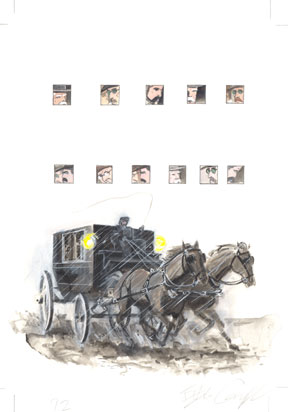
Agency, by Eddie Campbell. Captions and word
balloons were added in production.
I broke my rule for Mr. Campbell. Never met him, never corresponded with him. I saw him at ComicCon last July and almost approached his table, but he looked too busy and I never got back to him.
Eddie Campbell is probably best known for drawing From Hell, a retelling of the Jack the Ripper story written by Alan Moore. He's the creator of a long-running series titled Bacchus about the Greek gods living in modern times; a few semi-autobiographical works including The Fate of the Artist, which I thought was terrific; and The Black Diamond Detective Agency, based on an unproduced screenplay about a deadly train explosion in 1899 Missouri and a Hitchcock-esque man-on-the-run framed for it.
On paper, I'm not a particularly devout fan--haven't seen much Bacchus and didn't actually care for From Hell, which I found unengaging and lurid in a Bret Easton Ellis sort of way (I concede that if any subject cries out for carving up some women for fun, it's Jack the Ripper). However, Mr. Campbell's contributions are, I think, always excellent. Both his writing and artwork are interesting, witty, well-researched, and thoughtful. His confident, relaxed impressionistic style is built on a rock-solid foundation of craft. He's comfortable with ink, paint, collage, multi-media, typography: whatever he needs to get the effect he wants, he's not afraid to put it on the paper. He knows which rules to follow and break, and why. Everytime I read his work, I come away inspired to try two or three things I'd never thought of. In addition, I always get an absolute sense of integrity from his work.
Reading his blog for a while, I've also gotten a sense for Mr. Campbell as a person and I like the cut of his jib. He seems to be one of a small number of grown-ups working in the comics/cartooning/picture book/graphic novel business, and now I need to go on a little rant to explain what I mean by that.
Here's the Tirade
Comics are in an interesting, tricky place right now. First, there's the problem that much of the general public thinks comics are for kids. Some creators are striving mightily to have their comics taken seriously as literature, while others deliberately wallow in their low-class outsider status and confirm every slander against the entire medium. Others just don't care. Every few months for the past couple of decades, some reporter does a story with the headline "Pow! Bam! Comics Aren't Just for Kids Anymore!" Some of them have been about me. Every comics convention has at least one panel discussion on the topic of when comics will finally enter the mainstream. I've been on some of them.
As comics have been taken more seriously, they've drawn critics, students, analysts, theorists, and cranks. Much of their discourse happens on the Internet, though it occasionally spills over to print. There are people dedicated to making rules, defining terms, arguing what is or isn't a comic, deciding who's in or out of the club. Is it a comic strip, a comic book, an illustrated book, or a graphic novel? There are people who question whether "Prince Valiant" is a comic because it doesn't use word balloons or whether "Family Circus" is a comic because it doesn't show the passage of time via sequential panels. (Answer: they're comics. If your definition of comics excludes them the problem is yours, not theirs.) Webcomics spice the debate with arguments about what is or isn't a digital comic.
There are people who confidently declare that there are only eight kinds of this or four ways to do that, and whenever I hear that I immediately think of three other kinds of this and two different ways to do that, and then I realize what a waste of time it is. It all reminds me of a Victorian gentleman's butterfly collection in which the point isn't to appreciate butterflies or advance science, but to pin the right label on every specimen so it ends up in the proper cabinet drawer. That's the sport of it: getting the taxonomy right. And the way some of these guys talk, if they don't have a drawer for your butterfly, it might as well be a lemur.
In response to such as that, Mr. Campbell once assembled a tongue-in-cheek "Graphic Novel Manifesto." All 10 points can be read at the end of Mr. Campbell's Wikipedia entry; I'll just provide the first and last:
1. "Graphic novel" is a disagreeable term, but we will use it anyway on the understanding that graphic does not mean anything to do with graphics and that novel does not mean anything to do with novels.
10. The graphic novelist reserves the right to deny any or all of the above if it means a quick sale.
Yes! If I could be so bold as to sum up Mr. Campbell's perspective in one sentence, I'd say it's "Just shut up and make the things as best you can!" Don't worry about fitting into someone else's definitions or rules. Don't fret over whether its Number 6 or Number 7 on somebody's list of the only 12 things it could possibly be. It doesn't matter if it's a cartoon or comic or graphic novel. Like the shoe commercial said, Just Do It. If it's good, people will find it. None of them will care what it's called.
This was brought home to me in a small way at the San Diego Comic-Con last July, when I had dinner with Jeff Kinney, author of Diary of a Wimpy Kid. We were on our way to watch me lose two Eisner Awards and had a short chat about whether Jeff's book would be eligible for Eisner consideration next year. It looks like a comic--it's got little cartoon drawings with words coming out of characters' mouths--but, on the other hand, most of the book is typeset text (in a font made from Jeff's hand printing), so maybe it's more of an illustrated book or novel with pictures. As we were having this discussion, I realized two things: first, it was a ridiculous conversation that had absolutely no impact on what the book actually was and who would buy and read it; second, this was almost the only context in which that conversation had any merit whatsoever. The only people who should ever care are award administrators who need to decide which trophy to give you and bookstore clerks who need to figure out which shelf to put you on. It's otherwise useless, irrelevant, and probably counter-productive.
Anyway, in the weeks to come, we did figure out what to call Jeff's book: "Bestseller." Now with 26 weeks on the New York Times Bestseller List for Children's Chapter Books, including a stint at Number 1.
I've never liked the term "graphic novel," though I accept its practical utility. When I was making Mom's Cancer, I thought of it as a serial comic strip. In light of the rant above, then, I've been especially delighted that it's gotten some recognition from the American Library Association, the German Jugendliteraturpreis, and others as a work of youth literature. I didn't know I wrote a kids' book. Never intended it, my publisher never positioned it as such. It not only broke out of the graphic novel drawer others put it in, but the drawer I put it in. I think that's just wonderful.
Here are some questions I ask when reading anything--even a graphic novel. Does it reward my time and attention? Does it introduce ideas I've never had before? Is it skillfully made? On its own terms, does it accomplish its goals? Is it worth the $2, $12.95, or $200 I paid for it? Is it good?
Some people in comics/cartooning are doing excellent, ambitious, high-quality work. But far too often, based on what I see (which is far from the whole industry), a lot of creators demand literary respect but do little to earn it. They want to sit at the adult table but don't know how to use a knife and spoon. They have no idea what makes great literature great or why theirs falls short. They're their own worst enemies. Not all, but some. Many. Maybe most.
(What's funny is to read someone's high-minded academic defense of their comic as art and literature just as good as anything ever done by Hemingway or Joyce, and then go look at it and find an artless scrawl about a video-gaming slacker with a time machine and wise-cracking dinosaur. You're not part of the solution, dude, you're part of the problem.)
That's what I mean when I say Eddie Campbell is a grown-up. He not only knows how to use a knife and spoon but also a finger bowl and the funny little fish fork (metaphorically; I have no idea what his actual table manners are like). He's cranky. He's sat on too many panels dedicated to dissecting what graphic novels are and when they'll be respected as real books, and he's tired of it. Instead of endlessly debating, he works. He makes books with words and pictures that reward the reader's time and attention, introduce new ideas, accomplish their goals, and are worth the money people pay for them. Even more than his work, I appreciate and respect his attitude toward his work. It's worth breaking a rule--or bending a guideline--to have it in my home. It makes me happy.
.
Wednesday, October 17, 2007
More Jugendliteraturpreis

Friday, October 12, 2007
Deutscher Jugendliteraturpreis

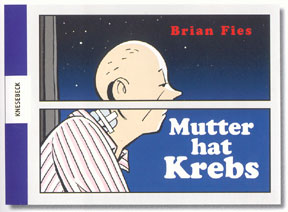
Sunday, October 07, 2007
S.F. 49ers 7, Baltimore Ravens 9
Saturday, October 06, 2007
Dreams
I always figured that was because the dreaming brain makes it up as it goes along. I assumed that, like a three-year-old telling a story of unrelated events linked by "and then ... and then ... and then ...," dreams aren't created with any particular structure, narrative, or destination in mind. It's as if that process demands some higher-brain storytelling function that just isn't engaged while asleep.
That's what I thought until last night, when I had a dream that was a brilliant short story with a beginning, middle, and a boffo surprise ending with an O. Henry twist that tied all the previous events together. I don't remember all the details but, when the dream climaxed with my car getting towed away, it was just the perfect ironic, inevitable culmination of that story. Perfect.
Now the question is: was this story really such a nifty little gem of narrative genius, or did I just dream that it was? I'll never know. In any case, it made me rethink some of my assumptions about dreaming.
By the way, I have had lucid dreams before. That's a dream in which you realize you're dreaming, and you're suddenly a god with a universe at your command. You can fly, breathe underwater, soar into space, all the while thinking, "This is just a dream, might as well enjoy it." Your own private Star Trek holodeck.
Physicist Richard Feynman wrote in his autobiography of disciplining his mind so he could dream lucidly at will. Every night he went to sleep knowing he'd be the hero in his own romantic fantasy adventures, and he said it was terrific fun for a while. Eventually, though, it began to wear on him, leaving him feeling tired, irritable, out of sorts. He finally realized his mind required the down time he was denying it, and stopped. The brain needs what it needs.
Although I've seldom found dreams useful, I do get my best creative work done first thing in the morning, still lying in bed about three-fourths awake. Cartoonist Lynn Johnston and others have written the same thing. I think the mind can still access the undisciplined freedom of dreams and yet is awake enough to guide it in productive directions. I'll often lie there semi-dozing and finally sit up to write down three or four ideas that are actually good. I've gotten adept at using that state of mind well. In some ways, it's the most productive part of my day.
At least that's what I tell my wife.
.
Friday, October 05, 2007
What My Harvey Award Looks Like
Tuesday, October 02, 2007
An Illustrated History
